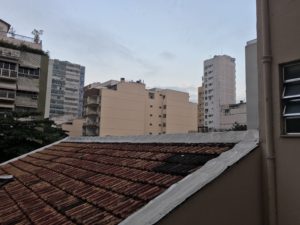Defining Rio de Janeiro: Cultural Nuances during the Brazilian “Winter”
 Rio de Janeiro is in the middle of a record-breaking winter. Uncharacteristic weather has forced the city’s people to adjust their behavior, dawn heavier clothes, stay indoors, and avoid Rio’s famous beaches. Residents fall ill in large numbers and the weather is the hottest—pardon the irony—topic of conversation. And the average temperature in this city-stopping cold front? The low 70’s.
Rio de Janeiro is in the middle of a record-breaking winter. Uncharacteristic weather has forced the city’s people to adjust their behavior, dawn heavier clothes, stay indoors, and avoid Rio’s famous beaches. Residents fall ill in large numbers and the weather is the hottest—pardon the irony—topic of conversation. And the average temperature in this city-stopping cold front? The low 70’s.
Clearly, Rio is a unique city. While, as a Californian, I understand a low tolerance for changing weather, this is just one example of Rio’s many distinct characteristics that have defined the past three weeks that I have spent here. As I prepare to move to São Paulo for my semester abroad next week, I’ve reflected on these many small differences, and because I feel that Brazilian culture rarely receives a fair representation in the States, I’ve outlined them a bit here.
The first, most notable aspect that defines Rio de Janeiro can only be described as the characteristic “look” of the city. It’s unlike anything I’ve seen before and its features are strikingly uniform. The city consists of mostly medium-height, beige or gray high rises, likely constructed in the 1970’s. Given Rio’s history and age—it recently turned 451 years old and previously served as the imperial capital—it seems odd that the city only sprung up a mere four decades ago. I suppose it’s a testament to Brazil’s recent rapid growth.
However, I am told the city did not always appear this way. A mere generation or two ago, Ipanema, the beachside neighborhood where I live, was filled with large homes and enough land to graze horses. Today, the beach lies invisible beyond apartment buildings that crowd the sky. I have yet to see a traditional, stand-alone home in the city proper. Graffiti is also commonplace, and even buildings in upscale neighborhoods like mine bear countless spray-painted political opinions and other illegible text. Also common is street art, and beautiful, spontaneous murals adorn street corners from Ipanema to the favelas.
On the other hand, as eyes trail down from the lofty windows above to the street at eye level, they find around nearly every residential entrance a tall, iron gate equipped with a 24-hour guard. Around storefronts, after shops have closed for the evening, one will also notice solid iron barriers that fully cover the glass windows through which shoppers peer during the day. Such is the risk of theft and violence.
Connecting these buildings in the city’s wealthy neighborhoods are traditional Portuguese Stone sidewalks, which consist of countless small black and white rocks laid together in intricate patterns that reflect the neighborhood to which they belong: Copacabana proudly bears an alternating wave pattern, while Ipanema and Leblon share a connected dot pattern. The decorated stones that greatly contrast from the dreary cement remind many that while Rio is an urban behemoth, its defining characteristic is that of beauty.
My most recent finding: the absolutely breathtaking city landscape. This week I hiked “Pedra Bonita” (Beautiful Rock), a gentle walk that takes no more than 30 minutes, and got a 360-degree view from nearly 2300 feet in the air of Zona Sul, the Atlantic Ocean, Barra de Tijuca and the rainforest that lies at the heart of the city. I think I finally understand why people love this place so much.
In many ways, Rio resembles an American city. It has restaurants, malls, museums, public transportation: all of the hallmarks of home. And yet, every minute of the near month that I’ve spent here has felt radically different than my time in DC or California. It’s something that’s hard to put my finger on, but it comes down to a pervasive, fundamental difference in every new place I explore, decision I make, assumption I find validated or discredited. All these small differences that I’ve outlined, along with the large differences that accompany Brazil’s state of development, serve to remind me that though our world may be globalized and American culture aggressively exported, foreign nations are just that—foreign. And that is vital knowledge to remember both in our own journeys toward cultural awareness as well as in global politics and diplomacy. By learning the differences that define us, we can find common ground.


